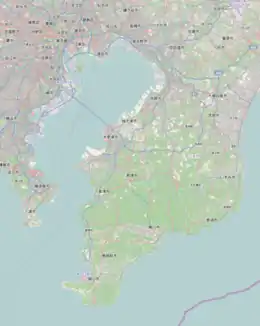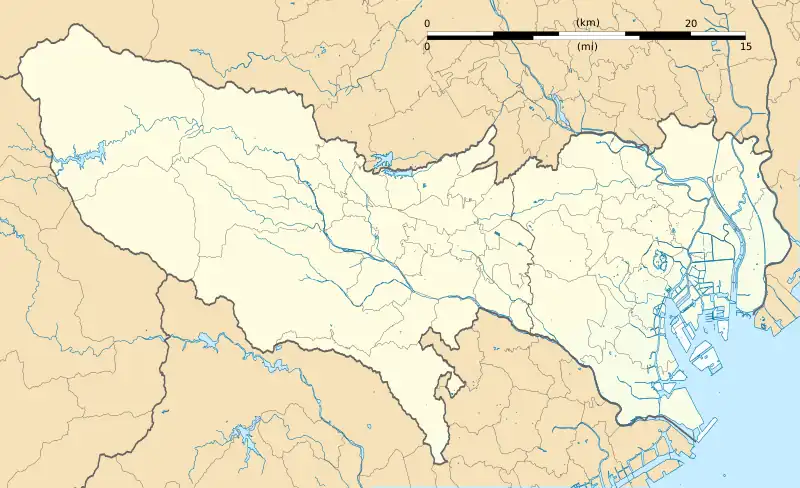Ochanomizu Station 御茶ノ水駅 | |
|---|---|
.jpg.webp) Ochanomizu Station | |
| General information | |
| Location | Tokyo Japan |
| Operated by | |
| Line(s) | |
| Location | |
 Ochanomizu Station Location within Special wards of Tokyo  Ochanomizu Station Ochanomizu Station (Tokyo Bay and Bōsō Peninsula)  Ochanomizu Station Ochanomizu Station (Tokyo)  Ochanomizu Station Ochanomizu Station (Japan) | |
Ochanomizu Station (御茶ノ水駅, Ochanomizu-eki) is a railway station in Tokyo, Japan, operated by the East Japan Railway Company (JR East) and Tokyo subway operator Tokyo Metro.
Lines
Ochanomizu Station is serviced by the following lines:
.svg.png.webp) JR East
JR East
- Chūō Main Line (including Chūō Line and Chūō-Sōbu Line)
- Sōbu Main Line (including Chūō-Sōbu Line)
 Tokyo Metro
Tokyo Metro
Passengers can also transfer to nearby Shin-ochanomizu Station on the Tokyo Metro Chiyoda Line.
Location
JR East's Ochanomizu station lies south of the Kanda River in Chiyoda ward. During the Edo period, the Kanda River was rerouted to pass through Ochanomizu, which was otherwise a highland between two valleys. Hijiribashi (聖橋, also known as Hijiri Bridge, Hijiribashi Bridge) crosses over the river near a station exit. The subway Marunouchi Line makes a short above-ground appearance as it passes over the river. Holy Resurrection Cathedral (Nicholai-dō) is easily accessible from the Hijiribashi Exit of this station. The Ochanomizu neighborhood is known for its many guitar and instrument shops.
The Tokyo Metro station is located in Bunkyō Ward, separate from the JR East station, and is served by the Marunouchi Line. The area is also served by the Chiyoda Line at Shin-Ochanomizu, which is connected to Ogawamachi on the Shinjuku Line.
JR East
JC03 JB18 Ochanomizu Station 御茶ノ水駅 | |||||||||||||||||||||||||||||||||
|---|---|---|---|---|---|---|---|---|---|---|---|---|---|---|---|---|---|---|---|---|---|---|---|---|---|---|---|---|---|---|---|---|---|
 JR East platforms, August 2019 | |||||||||||||||||||||||||||||||||
| General information | |||||||||||||||||||||||||||||||||
| Location | 2 Kanda-Surugadai, Chiyoda City, Tokyo Japan | ||||||||||||||||||||||||||||||||
| Operated by | |||||||||||||||||||||||||||||||||
| Line(s) |
| ||||||||||||||||||||||||||||||||
| Platforms | 2 island platforms | ||||||||||||||||||||||||||||||||
| Tracks | 4 | ||||||||||||||||||||||||||||||||
| Connections | C12 Shin-ochanomizu | ||||||||||||||||||||||||||||||||
| Construction | |||||||||||||||||||||||||||||||||
| Structure type | At grade | ||||||||||||||||||||||||||||||||
| Other information | |||||||||||||||||||||||||||||||||
| Station code |
| ||||||||||||||||||||||||||||||||
| Website | Official website | ||||||||||||||||||||||||||||||||
| History | |||||||||||||||||||||||||||||||||
| Opened | 31 December 1904 | ||||||||||||||||||||||||||||||||
| Passengers | |||||||||||||||||||||||||||||||||
| FY2013 | 104,737 daily | ||||||||||||||||||||||||||||||||
| Services | |||||||||||||||||||||||||||||||||
| |||||||||||||||||||||||||||||||||
The JR East portion of the station has two island platforms serving four tracks.[1] Tracks 1 and 4 (the outer tracks) serve trains on the Chūō Line whilst tracks 2 and 3 are used by trains on the Chūō-Sōbu Line.[1]
Platforms
| 1 | JC Chūō Line (Rapid) | for Shinjuku, Tachikawa and Takao |
| 2 | JB Chūō-Sōbu Line | for Shinjuku, Nakano and Mitaka |
| 3 | JB Chūō-Sōbu Line | for Kinshichō, Funabashi and Chiba |
| 4 | JC Chūō Line (Rapid) | for Tokyo |
There are two exits from Ochanomizu to street level. The larger of the two is the Ochanomizu-bashi exit on the western end of the station which features ticket vending machines, a JR reservation office, toilets, and lockers. The other is the Hijiri-bashi exit which only has ticket vending machines and toilets.[1]
Tokyo Metro
M20 Ochanomizu Station 御茶ノ水駅 | |||||||||||
|---|---|---|---|---|---|---|---|---|---|---|---|
-5.jpg.webp) Marunouchi Line platforms, February 2018 | |||||||||||
| General information | |||||||||||
| Location | 1-5-8 Yushima, Bunkyō-ku, Tokyo Japan | ||||||||||
| Operated by | |||||||||||
| Line(s) | M Marunouchi Line | ||||||||||
| Platforms | 2 side platforms | ||||||||||
| Tracks | 2 | ||||||||||
| Construction | |||||||||||
| Structure type | Underground | ||||||||||
| Other information | |||||||||||
| Station code | M-20 | ||||||||||
| Website | Official website | ||||||||||
| History | |||||||||||
| Opened | 20 January 1954 | ||||||||||
| Passengers | |||||||||||
| 2021 (Daily) | 42,427 | ||||||||||
| Services | |||||||||||
| |||||||||||
The Tokyo Metro station consists of two side platforms serving two tracks.[2]
Platforms
| 1 | M Marunouchi Line | for Tokyo, Ginza, Shinjuku and Ogikubo |
| 2 | M Marunouchi Line | for Kōrakuen and Ikebukuro |
History
The JR East station opened on 31 December 1904.[3] The Tokyo Metro station opened on 20 January 1954.[4]
Passenger statistics
In fiscal 2013, the JR East station was used by 104,737 passengers daily (boarding passengers only), making it the 34th-busiest station operated by JR East.[5] In fiscal 2013, the Tokyo Metro station was used by an average of 55,529 passengers per day (exiting and entering passengers), making it the 66th-busiest station operated by Tokyo Metro.[6] The average daily passenger figures for each operator in previous years are as shown below.
| Fiscal year | JR East | Tokyo Metro |
|---|---|---|
| 1999 | 118,211[7] | |
| 2000 | 116,955[8] | |
| 2005 | 106,967[9] | |
| 2010 | 101,617[10] | |
| 2011 | 100,518[11] | 51,629[12] |
| 2012 | 100,157[13] | 52,642[14] |
| 2013 | 104,737[5] | 55,529[6] |
- Note that JR East figures are for boarding passengers only.
Surrounding area
- Shin-Ochanomizu Station
- Akihabara
- Jinbōchō
- Kanda River
- Kanda Shrine
- Manseibashi
- Yasukuni-dōri
Connecting bus services
The Toei Bus operates local bus services from the following Ochanomizu Station bus stops.
Ochanomizu-ekimae (Ochanomizu Station)
No.1
- Cha 51: for Komagome-eki-minamiguchi (Komagome Station South Entrance)[15]
No.2
- Cha 51: for Akihabara-ekimae (Akihabara Station)[15]
No.3
- Higashi 43: for Tokyo-eki-Marunouchi-kitaguchi (Tokyo Station Marunouchi North Entrance)[15]
No.4
- Higashi 43: for Arakawa-dote-sōshajō-mae (Arakawa Riverbank Depot) and Kōhoku-ekimae (Kōhoku Station)[15]
Ochanomizu-ekimae (Higashi-guchi) (Ochanomizu Station (East Entrance))
No.5
- Gaku 07: for Tōdai-kōnai (The University of Tokyo Hongo Campus)[15]
See also
References
- 1 2 3 Ochanomizu station map JR East Retrieved 13 January 2009
- ↑ Ochanomizu Station diagram Retrieved 4 September 2009. (in Japanese)
- ↑ JR East station information Retrieved 4 September 2009. (in Japanese)
- ↑ Terada, Hirokazu (July 2002). データブック日本の私鉄 (Databook: Japan's Private Railways). Japan: Neko Publishing. p. 213. ISBN 4-87366-874-3.
- 1 2 各駅の乗車人員 (2013年度) [Station passenger figures (Fiscal 2013)] (in Japanese). Japan: East Japan Railway Company. Retrieved 12 September 2014.
- 1 2 各駅の乗降人員ランキング [Station usage ranking] (in Japanese). Tokyo Metro. Retrieved 12 September 2014.
- ↑ 各駅の乗車人員 (1999年度) [Station passenger figures (Fiscal 1999)] (in Japanese). Japan: East Japan Railway Company. Retrieved 12 September 2014.
- ↑ 各駅の乗車人員 (2000年度) [Station passenger figures (Fiscal 2000)] (in Japanese). Japan: East Japan Railway Company. Retrieved 12 September 2014.
- ↑ 各駅の乗車人員 (2005年度) [Station passenger figures (Fiscal 2005)] (in Japanese). Japan: East Japan Railway Company. Retrieved 12 September 2014.
- ↑ 各駅の乗車人員 (2010年度) [Station passenger figures (Fiscal 2010)] (in Japanese). Japan: East Japan Railway Company. Retrieved 12 September 2014.
- ↑ 各駅の乗車人員 (2011年度) [Station passenger figures (Fiscal 2011)] (in Japanese). Japan: East Japan Railway Company. Retrieved 12 September 2014.
- ↑ 駅別乗降人員順位表(2011年度1日平均) [Station passenger figures (Fiscal 2011)] (in Japanese). Japan: Tokyo Metro. Retrieved 12 September 2014.
- ↑ 各駅の乗車人員 (2012年度) [Station passenger figures (Fiscal 2012)] (in Japanese). Japan: East Japan Railway Company. Retrieved 12 September 2014.
- ↑ 各駅の乗降人員ランキング (2012年) [Station usage ranking (2012)] (in Japanese). Tokyo Metro. Retrieved 12 September 2014.
- 1 2 3 4 5 御茶ノ水駅 バスのりば (in Japanese). Japan: Tokyo Metropolitan Bureau of Transportation. Retrieved 15 March 2017.
External links
- JR East station information (in Japanese)
- Tokyo Metro station information (in Japanese)